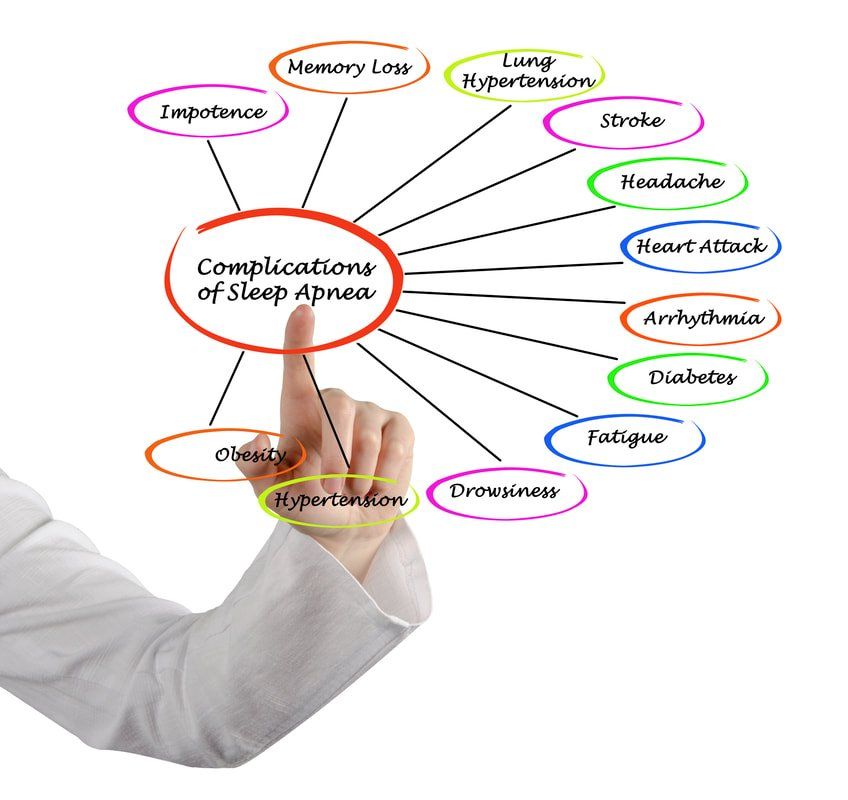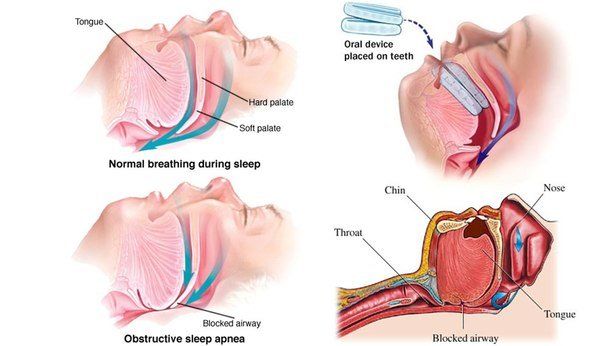Sleep Apnea
What is Sleep Apnea?
Sleep apnea is a serious sleep disorder that occurs when a person's breathing is interrupted during sleep. People with untreated sleep apnea stop breathing repeatedly during their sleep, sometimes hundreds of times. This means the brain, and the rest of the body, may not get enough oxygen.
There are two types of sleep apnea: Obstructive Sleep Apnea (OSA) and Central Sleep Apnea.
Obstructive Sleep Apnea (OSA) is the more common of the two forms of apnea. It is caused by a blockage of the airway, usually when the soft tissue in the back of the throat collapses during sleep.
In Central Sleep Apnea, unlike OSA, the airway is not blocked, but the brain fails to signal the muscles to breathe, due to instability in the respiratory control center.
Sleep apnea can affect anyone at any age, even children. Risk factors include:
- Being male
- Being overweight
- Being over the age of 40
- Having a large neck size (17 inches or greater in men and 16 inches or greater in women)
- Having large tonsils, a large tongue, or small jaw bone
- A family history of sleep apnea
- Gastroesophageal reflux (GERD)
- Nasal obstruction due to a deviated septum, allergies or sinus problems
If untreated, sleep apnea can result in a growing number of health issues including:
- High blood pressure
- Stroke
- Heart failure, irregular heartbeats, and heart attacks
- Diabetes
- Depression
- Worsening of ADHD
- Headaches
What is a Sleep Study?
If you have symptoms of sleep apnea, your physician or the Team at Ligocki Dental Group may ask you to have a sleep apnea test called a polysomnogram. This may be done in a sleep disorder center or even at your own home. Call Ligocki Dental Group today to schedule your Sleep Consultation and your at home sleep study!
A polysomnogram -- or sleep study -- is a multiple-component test that electronically transmits and records specific physical activities while you sleep. The recordings are analyzed by a qualified sleep specialist to determine whether or not you have sleep apnea or another type of sleep disorder.
Watch Video Above For Instructions of Home Sleep Study Machine
If sleep apnea is determined, you maybe asked to do further sleep testing in order to determine the best treatment options. The use of cone-beam computer tomography (CT scan) for imaging the upper airway structure of Obstructive Sleep Apnea patients.
Treatment for Obstructive Sleep Apnea depends on a number of factors, including the severity of your problem, the physical structure of your upper airway, other medical problems you may have, as well as your personal preference. You should work with your physician, sleep specialist, and the Team at Ligocki Dental Group to select the best treatment option for you.
Dental Devices for Sleep Apnea
If you have mild to moderate Obstructive Sleep Apnea, your physician and the Team at Ligocki Dental Group may recommend an oral appliance as an effective treatment option. These devices, which must be fitted by a dentist, and worn in the mouth at night include: mandibular advancement devices and tongue retaining devices.
Mandibular advancement devices (MADs) are the most widely used mouth device for sleep apnea; MADs look much like a mouth guard used in sports. The devices snap over the upper and lower dental arches and have metal hinges that make it possible for the lower jaw to be eased forward.
Tongue retaining devices are used less commonly than MADs. This device is a splint that holds the tongue in place to keep the airway open.
For people with mild to moderate sleep apnea, particularly those who sleep on their backs or stomachs, dental devices may improve sleep and reduce the frequency and loudness of snoring. However, dental devices do have some potential drawbacks, including: altered bite, movement of teeth, pain, arthritis of the temporomandibular joint (TMJ), dry lips, and excessive salivation.
If you are fitted with a dental device you should have a checkup early on to see if it is working and periodic checkups for possible adjustment or replacement. If you experience pain or changes in your bite, your dentist at Ligocki Dental Group who fitted your device may be able to make modifications to correct the problem.
The best treatment for Obstructive Sleep Apnea depends on a number of factors, including the severity of your problem, the physical structure of your upper airway, other medical problems you may have, as well as your personal preference. You should work with your physician, dentist at Ligocki Dental Group, and sleep specialist to select the best treatment option for you.
Would you like to schedule a Sleep Consultation?
Complete the form below and a team member of Ligocki Dental Group will contact you soon!
References
Patterson Companies. Retrieved October 15, 2018, from https://www.caesycloud.com/pageViewer.aspx?presentation=1462
Patterson Companies. Retrieved October 15, 2018, from https://www.caesycloud.com/pageViewer.aspx?presentation=1463
Patterson Companies. Retrieved October 15, 2018, from https://www.caesycloud.com/pageViewer.aspx?presentation=1464



